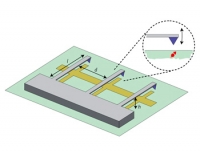
[2010-05-31] In an advanced online publication in Nature Physics Peter Rabl and colleagues from the Institute for Theoretical Atomic, Molecular and Optical Physics in Harvard together with Peter Zoller propose a new concept of a quantum spin transducer based on nanoelectromechanical resonator arrays.
Isolated electronic and nuclear spins associated with impurity atoms in solids constitute a promising platform for the implementation of quantum computing protocols. Spin degrees of freedom provide an excellent quantum memory due to their weak magnetic interactions with the environment and embedding the spins in a solid state matrix avoids trapping requirements. However, the weak magnetic dipole moment makes it difficult to couple spin qubits over distances larger than tens of nanometers which currently limits the implementation of quantum logic operations in these systems.
In this work Peter Rabl and colleagues have proposed a novel realization of a quantum data bus for spin qubits where long-range interactions between two or multiple spins are mediated by nanoelectromechanical resonator arrays. In this scheme the spins are coupled to the motion of magnetized mechanical resonators via magnetic field gradients. By application of an appropriate gate voltage the mechanical system is charged and the magnetic moments associated with spin qubits are effectively amplified to enable coherent spin–spin coupling over distances exceeding 100 µm through Coulomb forces.
Apart from this amplification of spin-spin interactions the key advantage of this approach is that multiple spin set-ups can be designed and controlled using different electric-circuit layouts which provides the necessary flexibility for the implementation of a large scale quantum computer. The goal to observe quantum effects with a macroscopic object like a nano-mechanical resonator is currently pursued in many laboratories around the world. This work shows that research on macroscopic quantum objects is not only of fundamental interest, but will also lead to new applications for mechanical systems ranging from quantum information processing to nanoscale sensing techniques at the quantum limit.